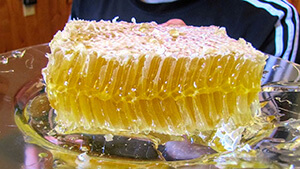
Extracted honey can never hold a candle to honey in the comb. Imagine harvesting the choicest Zinfandel, Chianti, Syrah, and Merlot, then swirling them altogether in a cavernous vat. The result is anemic red wine. The high notes and the low, the color and the bouquet, are all confused into an insipid muddle not memorable in the least. The word that comes to mind is “boring.”
Likewise, centrifugal extractors meld honey produced from a variety of flowers, grown in diverse soils, and at different points in the season, into a tedious syrup. Extracted honey reminds me of vegetable soup from a can where the peas, carrots, and potatoes all taste alike except for their shape. If I want nondescript sweetness in a jar, why bother keeping bees?
Cell by cell
Comb honey, on the other hand, is a magical experience. Each individual cell is a unique flavor packet. The contents were harvested in a relatively short period of time — perhaps only a day — and often the nectar came from a single species, or nearly so. It doesn’t have the same flavor as the honey harvested ten days later, or twenty. Chances are it’s not the same honey that’s packed in the next super or even the next frame.
The only way to taste the nuanced tang of day-to-day production is to leave the honey in the comb until you’re ready to eat it. Savoring honey cell-by-cell and comparing the flavors of cells with different colors is a one-of-a-kind adventure, experienced by very few in our modern world where maximum production is the gold standard.
No apologies
Yes, I am a comb honey fanatic and make no apologies for it. A shortage of great comb honey is the sole reason I became a beekeeper, and I have never — not once in my entire beekeeping career — put a single frame of my honey into an extractor. Centrifugal extractors not only mix the honey, but aerate it by flinging it through the air before it splats on the cylinder wall, accelerating oxidation and diminishing the flavor even more.
On the rare occasion when I want some extracted honey for a recipe, I mash some cells with a fork. When I want to sell honey in the comb, it disappears so fast it’s not worth setting up a table.
Honey in the kitchen
Oddly, beekeepers often dismiss comb honey before they start, thinking it is somehow difficult, complicated, or too much trouble. Worse, they don’t seem to know what to do with it in the kitchen. “How do I eat it?” is a common question. So today, I want to share some ideas for preparing and serving honeycomb. But before we go there, we need to talk about “the wad.”
If you ask around, people who have consumed comb honey usually focus on the wad, a dense, indigestible, flavorless glob that remains after the honey disappears. Either they love to chew on the wax like gum or they absolutely detest having the wad in their mouth. Now, listen carefully: If you end up with a wad, it is for one of two reasons. Either the comb was produced improperly or it was served incorrectly. Comb honey should never produce a wad. Done right, you should never even notice the comb.
What makes tender comb?
The best honeycomb is young and malleable. Beeswax has lots of volatile components when first secreted by bees, and these substances keep the wax soft. You’ve certainly noticed that new combs are bendy and tear easily, and only after time do they become hard and brittle. If you are going to eat the comb, it’s best in its soft and tender youth.
Because old wax gets stiff, comb honey should never be made with foundation. By definition, foundation is old wax. Even the super-thin stuff sold specifically for comb honey won’t prevent wads. Cut a honeycomb in two and look inside. The midrib, which forms the centerline between the two sides of a comb, should be just as thin as the hexagonal walls. It should be transparent, not white and thick.
Burr comb goodness
Some of the best honeycomb I’ve ever eaten was burr comb cut from rapidly expanding colonies. It may have been built between frames or inside an empty feeder rim. These are comb honey gold mines — built fast, filled quickly, and still pliant. Best of all, they contain no foundation.
When I prepare comb honey supers in spring, I use a starter strip in each frame. I simply take a piece of the super-thin foundation, cut it in narrow strips with a rotary cutter, and ….


